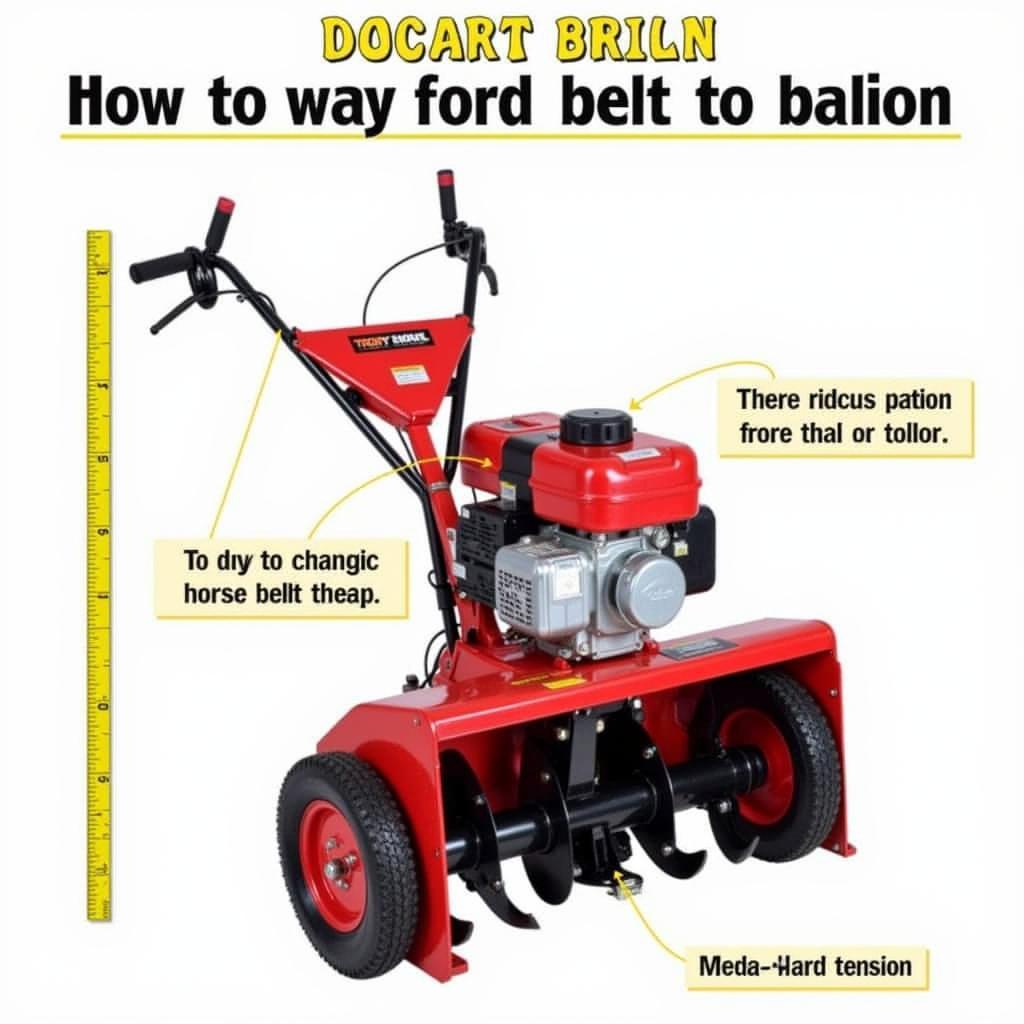Getting your Troy-Bilt Horse tiller to perform at its best involves understanding the importance of proper belt adjustment. A correctly adjusted belt ensures efficient power transfer, prolongs the belt’s lifespan, and prevents unnecessary strain on the engine. This comprehensive guide will walk you through everything you need to know about belt adjustment on your Troy-Bilt Horse, from identifying the signs of a worn or loose belt to adjusting it like a pro.
Understanding the Importance of Belt Adjustment on a Troy-Bilt Horse
The belt on your Troy-Bilt Horse tiller is a crucial component that transmits power from the engine to the tines, allowing it to churn the soil effectively. A loose belt can slip, reducing the tiller’s power and efficiency. Conversely, a belt that’s too tight can put excessive strain on the engine and other components, leading to premature wear and tear. Proper belt adjustment, therefore, is essential for optimal performance and longevity. Recognizing when your belt needs attention is the first step towards a smooth-running tiller.
Recognizing the Signs of a Worn or Loose Belt
Several signs indicate your Troy-Bilt Horse’s belt might need adjusting or replacing. These include:
- Slipping: If you notice the tines slowing down or stopping under load, even when the engine is running at full throttle, a slipping belt is a likely culprit.
- Squealing: A high-pitched squealing sound, especially under load, can also indicate a loose or slipping belt.
- Visible Wear: Check the belt for cracks, fraying, or excessive wear. If the belt appears significantly worn, it’s best to replace it.
- Reduced Performance: A general decrease in the tiller’s performance, like difficulty digging into hard soil, could point to a belt issue.
Step-by-Step Guide to Belt Adjustment on a Troy-Bilt Horse
Before you begin, always refer to your owner’s manual for specific instructions and safety precautions for your model. Here’s a general guide:
- Safety First: Disconnect the spark plug wire to prevent accidental starting.
- Locate the Belt Tensioner: The location and type of tensioner will vary depending on the model. Consult your manual.
- Loosen the Tensioner: Use the appropriate wrench to loosen the tensioner bolt or lever.
- Adjust the Belt: Adjust the belt to the proper tension, as specified in your owner’s manual. Typically, there should be about ½ to ¾ inch of deflection when you press on the belt midway between the pulleys.
- Tighten the Tensioner: Securely tighten the tensioner bolt or lever.
- Double-Check: Start the engine (after reconnecting the spark plug wire) and observe the belt operation. Ensure it’s running smoothly and not slipping.
 Adjusting the Belt on a Troy-Bilt Horse Tiller
Adjusting the Belt on a Troy-Bilt Horse Tiller
Maintaining Your Troy-Bilt Horse’s Belt for Optimal Performance
Regular maintenance can significantly extend the life of your belt. Keep the belt clean and free from debris. Avoid overtightening the belt, as this can cause premature wear. Inspect the belt regularly for signs of wear and tear, and replace it when necessary.
Troubleshooting Common Belt Adjustment Issues
- Belt Still Slips After Adjustment: If the belt continues to slip after adjustment, it might be stretched or damaged and require replacement.
- Difficulty Locating the Tensioner: Consult your owner’s manual for the precise location of the tensioner on your specific Troy-Bilt Horse model.
- Overtightening the Belt: Be careful not to overtighten the belt, as this can damage the engine and other components.
 Checking the Belt Tension on a Troy-Bilt Horse Tiller
Checking the Belt Tension on a Troy-Bilt Horse Tiller
“Regularly inspecting and adjusting the drive belt is crucial for maintaining the efficiency and longevity of your Troy-Bilt Horse tiller,” advises John Deere, a seasoned agricultural mechanic with over 20 years of experience. “A properly tensioned belt ensures optimal power transfer and prevents unnecessary strain on the engine and other components.”
Conclusion
Proper Belt Adjustment Troy Bilt Horse is vital for maintaining its performance and extending its lifespan. By understanding the signs of a worn or loose belt and following the correct adjustment procedure, you can keep your Troy-Bilt Horse running smoothly for years to come. Regular maintenance and prompt attention to any issues will ensure your tiller continues to be a reliable workhorse in your garden.
 Replacing the Belt on a Troy-Bilt Horse Tiller
Replacing the Belt on a Troy-Bilt Horse Tiller
“Investing in a quality replacement belt and taking the time to adjust it correctly can save you money and headaches in the long run,” adds Maria Sanchez, a small-scale farmer and long-time Troy-Bilt user. “A well-maintained tiller is a valuable asset for any gardener.”
FAQ
- How often should I check my Troy-Bilt Horse’s belt tension?
- What are the signs of a worn-out belt?
- Can I adjust the belt myself, or do I need a professional?
- What type of belt does my Troy-Bilt Horse use?
- Where can I buy a replacement belt?
- What happens if I overtighten the belt?
- How do I find the belt tensioner on my specific model?
For further assistance, please contact us at Phone Number: 0772127271, Email: [email protected] or visit our address: QGM2+WX2, Vị Trung, Vị Thuỷ, Hậu Giang, Việt Nam. We have a 24/7 customer service team.